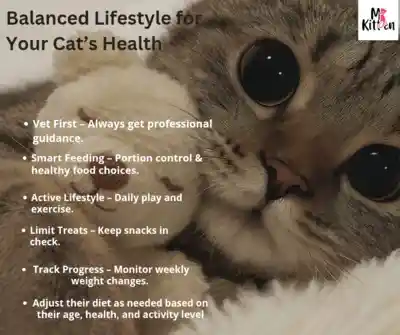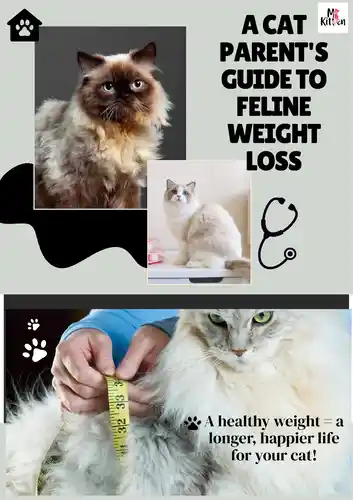Easy Ways to Get Your Cat to Lose Weight
Simple Strategies to Support Your Cat's Weight Loss Journey
Obesity in cats has become a growing concern, with approximately 60% of felines being overweight or obese, leading to serious health issues like diabetes, arthritis, and heart disease.
A healthy weight is crucial for your cat’s overall well-being. To achieve this, setting a tailored diet plan is essential. Consulting with a veterinarian is the first step to determine the ideal weight and diet for your cat.
Setting realistic targets and tracking progress is vital. Regular exercise, such as taking your cat out for play, can also aid in weight loss. Maintaining weight loss over time requires patience and dedication.
Easy Ways to Help Your Cat Shed Excess Weight
Assessing Your Cat's Weight Problem
Evaluating your cat’s weight problem is essential for devising an effective weight loss plan. The first step involves understanding the factors contributing to your cat’s weight gain.
A crucial aspect of assessing your cat’s weight is getting a professional evaluation from a veterinarian. They can provide insights into your cat’s overall health and recommend a suitable diet.
Here are some key factors to consider when assessing your cat’s weight:
- Your cat’s current weight and body condition score
- Dietary habits, including the type of food and feeding schedule
- Level of physical activity and exercise
- Any health issues that could be contributing to weight gain
For cats that are overweight, several tips can help. These include adjusting their diet to a healthy cat diet and increasing their physical activity. Some effective strategies include:
- Feeding a balanced and nutrient-rich diet
- Limiting treats and snacks
- Encouraging more physical activity through play
By understanding these factors and implementing the right strategies, you can help your cat achieve a healthier weight.
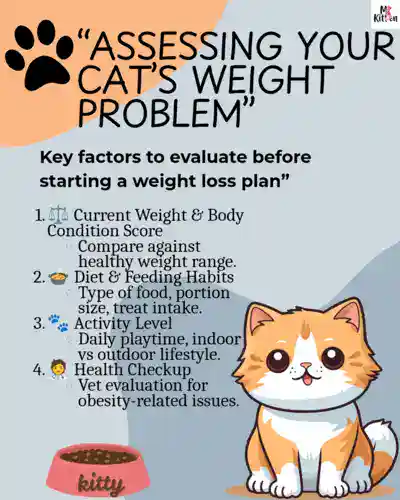
How to Help Your Cat Lose Weight?
Who does not love to have a fluffy cat in their laps? A few ounces might not look harmful, but the fat layer tends to cause some severe health issues to your cat. Ranging from a shortened lifecycle to damage the heart, obesity in cats has various risks that can put your little pet in danger. It has observed that cats tend to become inactive and lethargic. And obviously, nobody would ever be relieved to see a fat and unhealthy cat laying in their living room or lazing around in the house.
A combination of diet, exercise, and lifestyle adjustments is key to helping your cat lose weight. Feline obesity prevention is a critical aspect of maintaining your cat’s overall health, and implementing effective cat exercise routines can significantly contribute to achieving a healthy weight.
To start, it’s essential to engage your cat in regular physical activity.
Let us have a look at some approaches to make your obese cat lose all of its excess weight so that you two enjoy the quality time together playing.

Full Steps - How to Help Your Cat Loose Weight
1. Set a Diet Plan
This process should primarily focus on the calorie count and deficit in your cat’s food. While planning a diet for your pet, keep in mind that there should be a perfect balance of nutrients and other essential vitamins that would keep them away from getting fat. To maintain a healthy weight for your kitty, make sure you feed them with food that is calorie-balanced.
2. Get a Vet Evaluation
Before even starting with the weight loss plan, recommend that you get an appointment with the vet for your cat. A vet can easily trace down any probability of upcoming disease due to obesity. A vet can carry out a series of physical tests to understand the type of risks that the cat can face if not taken care of. Doctors believe diabetes to be a common disease that an obese cat is susceptible to. You can even ask your vet for a nutrition-rich diet for your kitty.
3. Set a Target
Whether you have a Persian Cats or any other fancy-looking breed such as a Persian kitten, you might be aware of their average weight. You can consider your vet’s assistance in deciding a target bodyweight and work according to it. For that, you would probably need to run some physical tests. Also, each cat’s ideal body weight depends on its age and size. Usually, a domestic cat weighs eight to ten pounds but depending on the cat’s obesity levels. The vet might recommend an ideal weight or help set the weight loss target for every period.
4. Take Your Cat Out
This process is simple but requires you to put your shoes on. You can grab a leash and take your cat out for a walk in the park. Some of you might find it difficult as indoor cats are not comfortable with exercising or working out. A one-time walk in the park proves to be beneficial for both the owner as well as the pet cat.
You can even bring in some scratching poles for your kitty. This would help your overweight cat to exercise as they love staying indoors and could not couple well with other felines in the park or across the block.
5. Maintain The Weight
Now when your pet has finally lost those extra pounds, all you need to worry about is that the excess fat does not come back again. You can get a small weighing machine and monitor their body weight regularly. You can maintain a log and note down the bodyweight so that it is easy for you to track it in the future if the cat gains another set of pounds.
6. The Process Takes Time
A drastic weight loss might delight you, but it takes less time to learn the weight again. You should be careful while executing your weight loss plan. Also, immediate weight loss leaves a long life impact on the organs such as the liver and heart. Cats tend to develop fatty liver disease, which is caused by drastic weight loss and proves to be harmful to a pet’s health.
Now when you know how to help your cat lose extra body weight, you need no longer worry about your cat developing fatal health disease. All you have to do is keep a check on the bowl portion of your cat and schedule an exercise routine for the cat. You can think of incorporating food with high moisture that would prevent dehydration issues and urinary infections. While being on a search for Persian cats for sale in Bangalore, Delhi, or other metropolitan cities, or got one among different types of breeds.
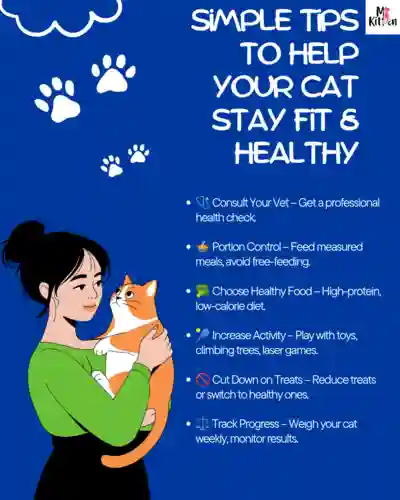
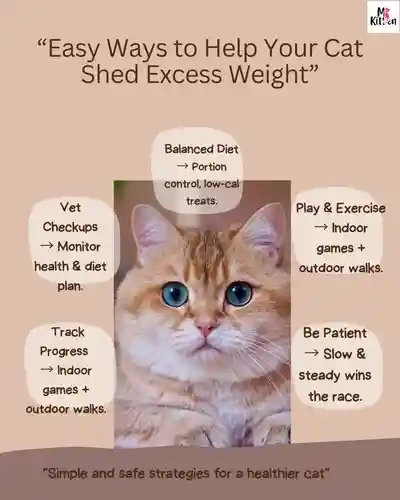
Exercise Ideas for Cats
Safe Indoor Activities
Can include playing with feather toys or laser pointers, which stimulate their natural hunting instincts. Interactive games that challenge your cat to work for treats are also beneficial.
Safe Outdoor Activities
such as walking on a leash or playing in a securely fenced area can provide additional exercise opportunities. It’s crucial to ensure your cat’s safety during outdoor activities by preventing escape or injury.
Setting a diet plan tailored to your cat’s specific needs is also vital. This involves consulting with a veterinarian to determine the ideal weight and dietary requirements for your cat. By combining a balanced diet with regular exercise, you can help your cat achieve and maintain a healthy weight, enhancing their quality of life.
To take your cat out for exercise safely, consider using a harness and leash designed for cats. This allows you to accompany them during outdoor activities, ensuring their safety while providing them with the necessary physical and mental stimulation.
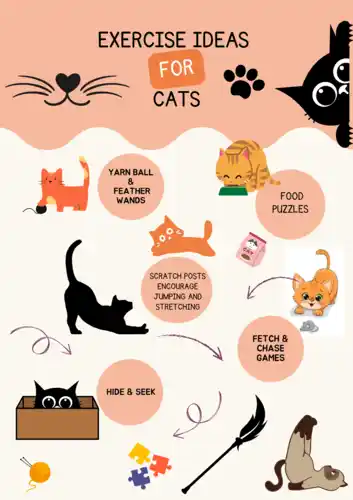
Maintaining Your Cat's Healthy Weight
Maintaining a healthy weight is crucial for your cat’s overall well-being and longevity. This involves a long-term commitment to monitoring their diet and ensuring they get adequate exercise.
Managing cat weight effectively requires regular check-ups with your veterinarian. These visits help ensure your cat remains on track and allow for any necessary adjustments to their diet or exercise routine.
Dietary supplements for cats can sometimes be recommended to support their overall health. However, it’s essential to consult with a veterinarian before adding any supplements to their diet. They can advise on the best course of action and recommend suitable products.
Here are some strategies for maintaining your cat’s weight loss:
- Monitor their food intake closely to prevent overeating.
- Ensure they get regular exercise through play or other activities.
- Schedule regular weigh-ins with your veterinarian.
- Adjust their diet as needed based on their age, health, and activity level.
By following these tips and maintaining a close relationship with your veterinarian, you can help your cat maintain a healthy weight and enjoy a longer, healthier life.
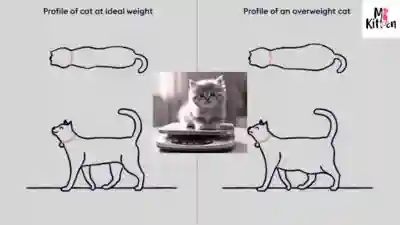
Conclusion
Helping your cat achieve a healthy weight is a journey that requires a structured approach, patience, and dedication. By working closely with your veterinarian to develop a customized weight loss plan, you can ensure your cat reaches their ideal weight. Veterinarian weight loss plans are designed to provide a safe and effective path to weight loss, taking into account your cat’s specific needs and health status.
The process of weight loss takes time, and it’s essential to be consistent and persistent. Regular monitoring and adjustments to the weight loss plan as needed will help your cat stay on track. By following these steps and maintaining a commitment to your cat’s health, you can help them achieve a healthier weight and improve their overall quality of life.
